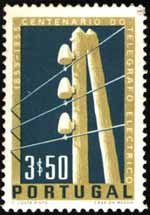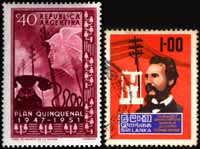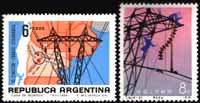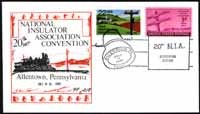Insulators are at the root of a technology that is prevalent throughout the world today, although many people do not know what they are.
According to Webster, to insulate means "to separate or cover with a nonconducting material in order to prevent the passage or leakage of electricity, heat, or sound."
The need for insulators began in the 1840s in response to the developing use of electricity and new forms of telecommunication.

Figure 1. Early insulators were crude, fulfilling the need to keep telegraph wires off the ground and away from the poles. Shown is Portugal Scott 815. |
A reliable method to keep electrical and communication wires off the ground was required. The wires were strung between poles and insulators were used to keep the wires away from the poles.
It wasn't long before individuals were looking for examples of insulators to collect, and an interesting new hobby was under way.
There are many instances of insulators appearing on postage stamps, usually in a supporting role.
An early style of insulator was the suspended hook insulator: an iron hook embedded in nonconducting material. This was often surrounded by wood and then nailed to the telegraph pole.
Portugal Scott 815 (Figure 1) shows this style of insulator in use. The 1955 stamp commemorates the centenary of the telegraph system in that country.
Various knobs and blocks were also used for insulation during this early period. Shortly thereafter, the glass and porcelain pintype insulators that are familiar today became the standard.
A wire groove in the insulator accommodates the line wire and a pinhole fits onto a pin that is attached to the crossarm on the pole.
Figure 2 shows a variety of close-up views of insulators in use.
Korea Scott 311 (left) celebrates the 75th anniversary of telegraph service in that country. Argentina Scott 622 (center) commemorates the 1952 International Telecommunications Union Plenipotentiary Conference in Buenos Aires. Mozambique Scott 812 (right) was issued in 1982 for the International Telecommunications Union Plenipotentiary Conference in Nairobi.

Figure 2. Standard insulators provide a wire groove in the insulator for the wire, and a pinhole to fit the pin. Close-up views of such insulators are shown on Korea Scott 311 (left), Argentina Scott 622 (center) and Mozambique Scott 812 (right). |
The earliest insulators were threadless. The pinhole was smooth, and the insulator was held onto the pin using a tarry substance.
In 1865, a method of creating internal screw threads in the pinhole and corresponding threads on a pin was developed to more securely affix the insulator on the pin.
The first telegraph message was sent May 24, 1844. The centennial of that event was commemorated by United States Scott 924, a 3 cent stamp issued May 24, 1944.
Telegraph lines started out as single wires, as illustrated by Australia Scott 526, commemorating the 1972 centennial of the Overland Telegraph Line.
Over time, there was a progression to multiple crossarms filled with wires and, of course, insulators. This change is illustrated by Brazil Scott 1886, a 1983 single-stamp pane commemorating the death of Louis Breguet.
Breguet (1804-1883) invented a number of items, including the telegraph transmitter pictured on the stamp.
When the telephone was invented by Alexander Graham Bell in 1876, insulators were needed for the telephone lines, just as they had been used for telegraph lines.

Figure 3. The invention of the telephone fueled the need for more and more insulators. The mythological Mercury (on Argentina Scott 597, at left) and the real-life Alexander Graham Bell (on Sri Lanka Scott 514, right) have both served as familiar symbols of communication. |
A telephone line is shown on a 1951 stamp from Argentina marking the close of that country's Five-Year Plan, Scott 597 (Figure 3, left).
Various stamps were issued to commemorate the 1976 centenary of the first telephone call, including Sri Lanka Scott 514, shown at left in Figure 3.
As railroads began crisscrossing the continent, there came the need for signal devices. The rights-of-way alongside the railroad tracks also provided a convenient location for telegraph and telephone lines. There are many stamps illustrating this relationship.
Soon after Thomas Alva Edison invented the incandescent lamp in 1879, electrical power lines were run to electrify the large cities. In 1935, the Rural Electrification Administration was formed to bring power and telephone service to farms in the United States, most of which did not have these utilities yet. United States Scott 2144 is a 22 cent stamp commemorating the 50th anniversary of the REA in 1985.
With the need for electrical power, there was a demand for larger insulators than those used for telegraph and telephone lines. Power lines required heavier wires and higher line voltages.
Some general styles of power insulators often seen today are illustrated by stamps shown in Figure 4.
High tension line suspension insulators can be seen on many stamps, such as Argentina Scott 914 (Figure 4, left).

Figure 4. As electrical power crossed the world, insulators came with it. High tension line suspension insulators appear on Argentina Scott 914 (left) and China Scott 1287. |
In 1976, China issued an unusual four-stamp set on the theme of power line maintenance. Scott 1287, pictured in Figure 4, shows a good close-up view of suspension insulators, which are strung together to provide proper insulation.
Insulators have been made in a wide variety of shapes, as can be seen from some of the accompanying illustrations. Another characteristic that unfortunately is not demonstrated well on stamps is the rainbow of colors in which insulators have been manufactured.
In general, glass insulators were not manufactured in specific colors. The minerals present in the raw material usually created aqua glass, but this was not always the case. And, since insulators weren't intended to be decorative, sometimes whatever glass was left in the vats was used when it came time to make more insulators.
Insulators have been made in colors such as cobalt and brilliant peacock blue, depression green, royal purple and all shades of amber. Insulators with milk glass or amber swirls, bubbles, and effects resembling snow are also quite attractive.
After methods of glass decolorization were developed, clear insulators became the norm.
Porcelain insulators were developed and used along with glass insulators in the United States. Porcelain insulators were glazed in a variety of colors, often to distinguish different wires. It is interesting to note that some of the later glass insulators were made in amber glass so they would look like brown porcelain and fit in on lines as replacements.
The possibilities for integrating insulators into the designs of postage stamps are numerous. As noted on some of the earlier examples, many countries have done so in celebrating anniversaries such as the invention of the telephone and the telegraph, and the coming of electricity.
The 1965 centenary of the International Telecommunications Union produced a multitude of relevant issues.
In the mid-1960s the insulator hobby was officially born, as collectors gathered together at swap meets and shows.
Today there are more than 2,000 insulator collectors in the organized hobby. Insulator clubs, national shows, and good reference books are all available.
Beginning in 1986, one insulator collector came up with the idea to create cacheted covers to commemorate the annual conventions of the National Insulator Association.

Figure 5. The 20th annual convention of the National Insulator Association produced a commemorative cover showing insulators in the cachet and in the cancel. The cover is franked with United States Scott 2144 and 924. |
Figure 5 shows one such cover, commemorating the 1989 NIA convention in Allentown, Pa. A variety of insulators can be seen in the borders of the cachet, and the pictorial cancel also shows an insulator.
The stamps used on these covers are usually either insulator-related or geographically related to the site of the convention. In this case, United States Scott 2144 commemorates the coming of electricity to rural America, and Scott 924 commemorates the centenary of the first telegraph message. Both stamps were mentioned here previously.
First-day covers are often a good source of insulator-related philatelic material, as cachets usually show a larger scene than the stamp itself can depict.
Information on insulator collecting is available by visiting the insulator collectors' site on the Internet's World Wide Web. The web site address is www.insulators.info
For details about joining the National
Insulator Association![]() ,
send an addressed, stamped envelope to the NIA membership director.
,
send an addressed, stamped envelope to the NIA membership director.
Jill Meier is a software engineer who lives with her husband, Bill, and their two cats in Carlisle, Mass. She has been collecting stamps for 30 years, with topical interests in earth features, marine life and, of course, insulators.
Jill and Bill have been collecting insulators for eight years, and are very active in the insulator hobby.
This is an edited version of a report from page 40 of the February 24, 1997, Linn's
Stamp News![]() .
.